Master’s student in theoretical physics Eva Groenendijk of Nikhef and the University of Amsterdam is spending two months in Rome for her research with a work grant. In the coming period she will write a weekly weblog about her experiences and her research work. Part 5: Art and plots.
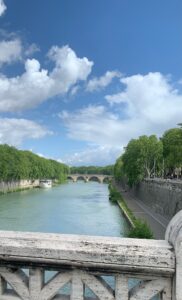
Last Wednesday on May 1 was Workers’ Day, which is a day off here when small festivals are organized. I had asked my Italian friends if they had plans to go to such an event. They replied that they made plans every year but then stood outside every year in the rain and cold, so they would rather not have that experience this year. At the time I asked the question, it was 30 degrees, so I didn’t believe any of it. But they were right.
Fortunately, despite the weather, it was a fun and productive week. A highlight of the weekend was a trip to the Galleria Nazionale d’Arte Moderna with my Dutch friends. The reason we went here was actually because the Villa Borghese was already sold out and this museum was next door, but it turned out to be a good (and cheaper) choice. I really like modern art, and one of my friends also paints himself, so we ended up spending the whole afternoon taking in the gigantic permanent exhibition they have there. Definitely recommended if you are ever in Rome!
Speaking of art, I made some very nice plots this week. Only the results in them are not so nice yet. Some strange things happen when comparing our results with cross sections I calculated analytically. But at least now you can clearly see that something goes wrong because I plotted it so nicely, so that’s the positive side. In addition, my Monte Carlo PhD course started the tutorial part, on MC@NLO. I had, I must admit, never heard of that before I started this PhD course, but it is nice to learn about a new Monte Carlo. The same goes for the event generator that Marco and I plan to use to resummarize charm production.
I find it quite difficult each time to start working with a new code, but when it finally succeeds it feels really good. I am now in the process of trying to compare the events produced by KaTie with the events coming out of POWHEG. It’s all a bit slow, it’s proving quite difficult to be working on two projects at the same time! In terms of managing time, switching between thought processes, etc. My tactic now is to switch between the two projects by getting coffee in between and not thinking about anything for a while. That works pretty well.
I also had lunch in Sapienza’s large cafeteria for the first time. My tennis friend had brought me along, and we had a full five-course meal for the money you get two coffees for in Holland. And it was delicious, too. By the way, my tennis friend also studies physics, and he took it upon himself to show me the nicest spots in the Marconi Building. The Marconi Building is one of two physics buildings at Sapienza, and to me it is a maze with unexpected corridors, shortcuts and hidden balconies everywhere.
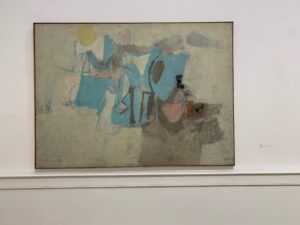
April 30: Birthday and Liberation Day.
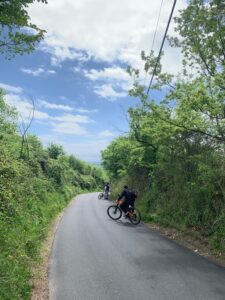
All in all, a successful birthday, which ended with eating a “pinse” at a little restaurant across the street. A pinse is actually exactly the same as a pizza, but in an elliptical shape. Even the Italians said they wouldn’t taste the difference. Apparently, twenty years ago someone used just slightly different dough for a pizza, called it a pinse and then marketed it as if it were a traditional Roman dish.
The Romans do have a knack for that, saying things are a thousand years older than they actually are – I learned from my archaeology friends.
So now in Italy it’s a long weekend from Thursday to Sunday, which gives me plenty of time to show my Dutch friends Rome, and in the meantime, well, study. Marco and I are exploring whether we can use an existing event generator for our purpose – implementing small-x resummation in charm production at the LHC and comparing that with the non-resummated results.
Now Marco has found this event generator (KaTie), which uses so-called ‘unintegrated’ Parton Distribution Functions and an off-shell matrix element to resummate interactions up to leading log (LL) in small-x. Then KaTie puts the events into Les Houches Event files, which is very nice for us to use further. So it seems like a very good and easy idea to use this Monte Carlo. The only thing is that we do need to check if and how we can compare the results of this one-to-one with the results of POWHEG, the event generator we use for the non-resummed events. We’re working on that now. We ran into some problems because the only documentation of the code is the paper the creator wrote about it, which is not extremely extensive. But I’m starting to get somewhere now. I find that I really enjoy learning something new again and diving into the small-x topic. So I am very happy to be able to do that here in Rome, and also that Marco is so welcoming and helps me along!
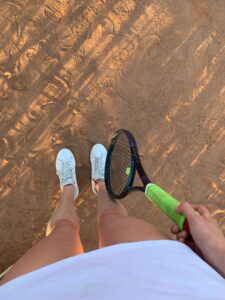
Apart from physics, I went mountain biking with Lorenzo and friends in a nature reserve near Rome, played tennis again (and won!), can now count to ten in Italian (and in Norwegian), and found out that I can’t play table soccer. I’ll stop there for now, but more next week!
April 19: Traffic and other chaos
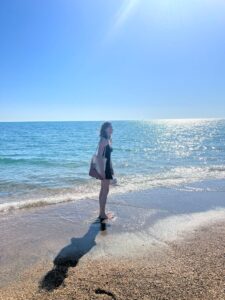
In any case, I was terrified on Roman roads, where stripes on the road seem to have no function and crosswalks are guidelines. Half an hour and three heart attacks later, we were at the tennis court, which was quite nice in the sunshine and among the trees. Besides, I turned out to be the better tennis player, which doesn’t happen often and which I was very pleased with. With the same friend, after playing tennis, I went for an aperitivo at a very nice place in Trastevere.
For dinner afterwards we went to eat something very strange, which is apparently part of the Rome experience. It was some kind of pizza, but shaped like a cone. A pizza ice cream. Pretty tasty. At the end of the evening I was brought back home nicely, and I survived all the car rides.
I also went to the beach. It was already summer in Rome this weekend, the comfortable 26 degrees was very warm even according to the Italians for this time of year. My roommates went with their archaeology friends to Ostia, a coastal town just west of Rome, and I decided to go with them to take my first dip of the year – except for a New Year’s swim. The water was lovely and we had a good time in the sun.
By the way, I hang out with these Norwegian people quite a lot, and get a little taken in by their Norwegian culture. ‘Go to Rome, become Norwegian,’ they tease me all the time. Pff, as if they have so many Italian friends.
Speaking of Italian friends, I went to a ‘PhD seminar’ last Wednesday night. That’s a biweekly event held at Sapienza where PhD students from all branches of physics can give an informal presentation about their research. This time a guy I already knew from my Monte Carlo PhD course happened to give a presentation, about pentaquarks. A comical thing happened halfway through his presentation, when two guys got up to leave before the end. They had to sneak past everyone to get to the door, but one of them tripped and fell sprawling on the floor. That’s what you get!
Apart from this interlude, it was also very nice to hear what other people are doing here for research and afterwards we went for a beer with a group in San Lorenzo. In doing so, I got into the middle of a discussion when one of the guys tried to convince me that red pizza is better than white pizza. Another disagreed whooping, and the whole thing exploded when someone suggested that Californian-style pizzas are pretty tasty, too. I thought this Italian passion for pizza came only from movies, but it turns out to be reality. My tennis friend – who, by the way, also studies physics – could confirm this. Another lesson learned.
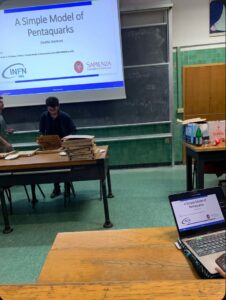
I have been working a lot this week comparing these first results with other simulations of the same process. We want to plot our (differential) neutrino scattering cross sections alongside those from GENIE. GENIE is an existing event generator for neutrino scattering that works with ROOT, which Valentina and I had never done before, so that takes some time. It’s starting to look like something by now, and I think it would be useful to be able to work with ROOT anyway.
And regarding my other project: Marco was at INFN in Frascati most of the week for a workshop, but fortunately he had given me some small-x homework. I read a lot of papers, mimicked calculations and went through code, and thought about how we could implement resummation. On that front it may have been a bit of a boring week, but I hope to have more to say next week because at least we made a plan this morning!”
April 12 First Italian sentences
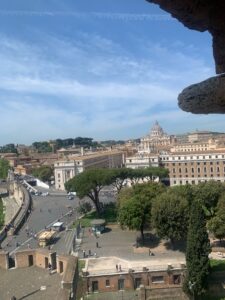
Before coming here, I knew as much as one Italian, Lorenzo, who lives and studies in Rome. Last week I had arranged to meet him for a drink before dinner, which is a very important ritual here.
Apparently the “aperitivo” is something typically Italian, although to my mind it is exactly the same as a drink. I had agreed to meet Lorenzo at a café near the university, the ‘bar dei brutti,’ which means ‘pub of the ugly people.’ Across the street is the “bar dei bella.
In no time, our table was suddenly filled with a dozen other friends of his. And that struck me as typically Italian. So I sat there with ten Italian guys – I was taller than each of them – and they taught me all sorts of things about the Roman language and culture, including my first sentence.
In addition, I found among them both a fellow physics student and a tennis partner, which I was very happy with.
Over the weekend, I also had the opportunity to explore a few things in the neighborhood where I live. Together with my Norwegian roommates Lena and Marita, I went into Trastevere, a nice neighborhood full of bars and fun. We ended up at Trastevere’s most famous pub, “Bar San Calisto,” where it was indeed incredibly nice.
The terrace sits on a little square that was filled with chatting people all evening, like a little festival. The atmosphere was good, as earlier that evening AS Roma had won a derby against Lazio. We happened to have watched that soccer match at home with our neighbors, so we could join in the conversation! Just not in Italian.
In addition, on the physics front, I experienced many fun things over the past few days. For starters, I had my first lecture of a PhD course I am participating in. It is a very happy coincidence that this course on QCD and Monte Carlo coincides exactly with my stay in Rome, and the lecturer was kind enough to let me join last-minute.
There are also weekly seminars organized here à la Nikhef colloquium, the first of which I attended, on sub-GeV Dark Matter. After the seminar, a whole buffet was waiting outside the lecture hall with a wide range of the most delicious pastries. I just took it from there.
I was also able to talk to the seminar speaker later. The nice thing is that my office is the “guest office,” which means that all the guest speakers get to sit there for a few days as well. That earned me some nice dark matter chats again, plus some tips for visiting Florence, where he came from.
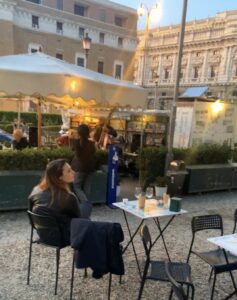
We want to make this Monte Carlo so that it can model neutrino scattering in the (future) Forward Physics Facility (FPF) better than it does now. The neutrinos entering these detectors come from the LHC (for example, from charmed mesons made in the proton-proton collisions), and that involves high energies.
That’s a regime where it’s good to see if you need to add resummation into your calculation for correct predictions. I won’t bore you with the details, but Marco and I are going to see if, in addition to the small-x resummation already done in the determination of the parton distribution functions, we can apply this resummation in the rest of the process. Just to see if that makes a big difference. Nice project!
With this goal in mind, Marco set aside time today to give me a lesson in small-x 101. This certainly proved necessary, and very useful. I hope that in the time I am here I can make some headway with this side project. In addition, of course, I am also very busy with our own project, so that will be a busy time. I like that. You guys will hear next week if I still like it then. ;-)”
April 5: Arriving and getting used.
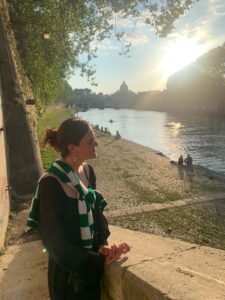
I won the Olga Igonkina Scholarship last December, which allows me to do part of my project abroad. And it just so happens that Juan has a collaborator at the INFN, so I can spend a few months working in the most beautiful city in the world!
Last (Easter) weekend I arrived in Rome – unfortunately just a few hours after the Pope ended his Orbe et Urbi. I live here with three roommates. Lena and Marita, two Norwegian students who happen to be taking a course in Roman archaeology at the Scandinavian Institute here during the exact same period as me, and Abhi, an American who has his own business and travels around Europe with his little laptop.
Abhi already knew a little restaurant where you get a free glass of prosecco and a limoncello upon entering, so at that place we immediately had our first home outing. That promises to be a fun time!
Shocks
My first day at the INFN, which is located on the Sapienza University campus, offered a few cultural shocks. The first thing I noticed when I walked in was that you have to throw coins into the coffee machine instead of holding a card in front of it. And there are purely espressos.
After drinking one of those cups of cordials (not expensive by the way, I was told that espressos are not allowed to be more expensive than a euro anywhere in Italy), I had my first meeting with Marco Bonvini, with whom I will be a guest at the university for the next few months.
I briefly told him what we have been working on for the past few months and showed some results. Then he explained to me a few things about small-x resummation in QCD, the topic he is working on. Fortunately, I had read up on it. He showed me my office some more and then we went to lunch.
Pizza in the park
For lunch, it is apparently normal here for the whole group to get pizza and eat it in a park. This is a tradition that I totally agree with! The park where we were sitting is apparently also regularly visited by all kinds of Nobel Prize winners, Marco told me. They had come across one just last week, whose (Italian) name unfortunately immediately escaped me.
I noticed anyway that everyone in this research group is Italian, which is quite a contrast to Nikhef, where I am used to at least half of the researchers being international. That gives me yet another reason to learn Italian.
I also received very welcome tips on fun things to do in Rome from all sides during lunch. “There is a lot you have to do here!” one of the PhD students pressed me. ‘Yes, a lot of work,’ Marco then said. With a wink.
Get used to it
Today I did find out that I need to get used to the Italian lifestyle. The previous day we had lunch at noon, so now I was ready at the meeting point again at the stroke of midnight, as is always the case in the Nikhef Theory Group. But no one was there. I kept waiting, until 1:30 p.m., and then finally went to get my own lunch.
Later in the afternoon I ran into one of the postdocs in the corridor. “We missed you for lunch! Apparently the Italians are a little less punctual than we are.
Vespa
Later in the afternoon I was meeting up with a Roman friend of mine. He showed up -even half an hour later than planned- on a Vespa from work to the university to spend twenty minutes standing and drinking an espresso with me and then scooting back. In short, all Italian style.
So does she do any physics at all? You may be wondering hopefully. Yes, but not everything fits into one blog! So next week more on neutrinos, resummation, and a Monte Carlo simulation.
Best, Eva”